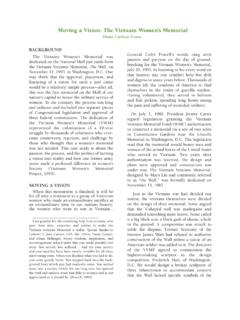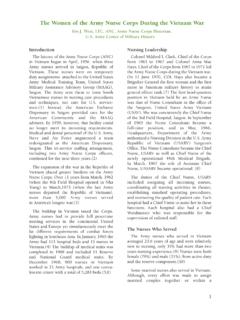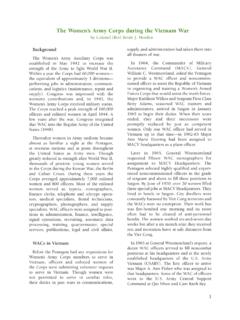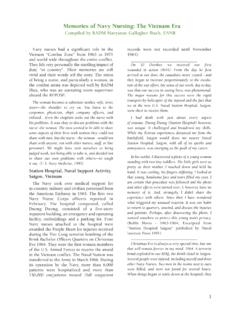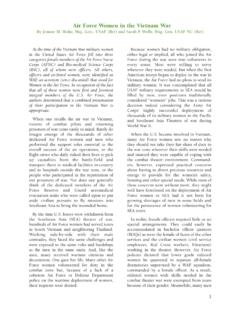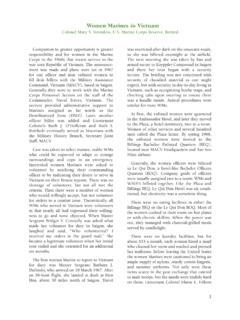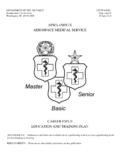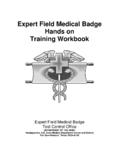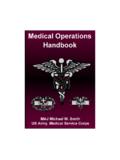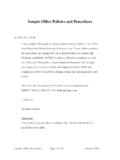Transcription of Army Medical Specialist Corps in Vietnam
1 BackgroundThough American military advisers had beenin French Indochina since World War II, and the American Advisory Group with 128positions was assigned to Saigon in 1950, theArmy Surgeon General did not establish a hospital in Vietnam until 1962 (the EighthField Hospital at Nha Trang) to supportAmerican personnel in country. Between 1964and 1969 the number of American military personnel in Vietnam increased from 23,000 to 550,000 as American combat units weredeployed to replace advisory personnel in support of military 1964 and 1973 the army SurgeonGeneral deployed 23 additional hospitalsestablished as fixed Medical installations witharea support missions.
2 These included surgical,evacuation, and field hospitals and a 3,000 bedconvalescent center, supported by a centralizedblood bank, Medical logistical support installations, six Medical laboratories, and multiple air ambulance ("Dust Off") units. Airevacuation of the wounded defied the terrain,mountainous canopied jungle, flooded delta,dusty plain, and provided increased securityfor the wounded. The army Medical buildup inVietnam was completed in 1968, with 5,283 army hospital beds available in understand the rationale for the assignments and missions of dietitians andphysical therapists during the Vietnam War, anoverview of the Medical chain of commandstructure in Vietnam is helpful.
3 Prior to August1967, the army placed Medical assets, including the 44th Medical Brigade, undercommand of the 1st Logistics Command with aseparate Office of the Surgeon reporting to theCommander, United States army , Vietnam (USARV). The Office of the Command Surgeonand the 44th Medical Brigade were combinedon 10 August 1967, and the 44th MedicalBrigade was then reassigned from 1st LogisticsCommand to USARV. The 44th included a Brigade Headquarters and three to fourMedical Groups which were established anddissolved as Medical needs dictated throughoutthe war.
4 On 1 March 1970, army Medical dualstaff functions were reduced with the establishment of the army MedicalCommand, Vietnam (Provisional).The 68th Medical Group, operational on 18 March 1966, was located in Long Binh and supported the Medical mission in the III and IVcombat tactical zones (CTZs). The 55thMedical Group, operational in June 1966, supported the Medical mission in the northernII CTZ and was located at Qui Nhon. The 43dMedical Group, operational in November1965, supported the Medical mission for southern II CTZ and was located at Nha , in October 1967, the 67th MedicalGroup, located at Da Nang, assumed Medical support responsibility for Physical TherapistsThe first member of the army MedicalSpecialist Corps to serve in Vietnam was a physical therapist who volunteered forVietnam duty from her posting at Fort Belvoir,Virginia.
5 And arrived with the 17th FieldHospital, Saigon, in March 1966 and February 1973, 43 Armyphysical therapists, 33 of whom were women,served in South Vietnam . They were assignedin the II, III, and IV combat tactical zones at the8th (Nha Trang) and 3d and 17th (Saigon)Field Hospitals, the 12th (Cu Chi), 24th (LongBinh), 29th (Can Tho), 36th (Vung Tau), 67th(Qui Nhon), 71st (Pleiku), 85th (Qui Nhon),93d (Long Binh), and 95th (Da Nang)Evacuation Hospitals, 3d Surgical Hospital(Dong Tam), the 6th Convalescent Center(Cam Ranh Bay)
6 , and MACV treated military personnel from theSEATO allied nations Australia, Korea, NewZealand, Thailand, the Philippines, SouthVietnam and the United States. Their patientsalso included civilians and prisoners of war. A total of seven army physical therapists, sixArmy Medical Specialist Corps in Vietnam Colonel Ann M. Ritchie Hartwick1women and one man, served as physical therapy consultants to the Commander, 44thMedical 1967 army physical therapists begantreating Vietnamese military personnel and civilians in Armyhospitals.
7 This interactionexpanded to patient and staffphysical therapy instruction inARVN ( army , Republic of Vietnam ) hospitals and select-ed Vietnamese Medical staffmembers affiliated with Armyphysical therapy clinics in Japanand Okinawa. As American combat troops were deployedhome from Vietnam in 1970 andthe South Vietnamese govern-ment became more responsiblefor the outcome of the war, theArmy physical therapist advisersassigned to MACV (MilitaryAssistance Command, Vietnam )
8 Headquarters developed eightweek courses of instruction inphysical and occupational therapy techniques for bedside rehabilitation of Vietnamesepatients at the 2700-bed hospitalat Cong Hoa, and compiled an illustrated basic course text which was translated into importance of physical therapy to theindividual soldiers whom army physical therapists treated and rehabilitated remains apriceless gift. It restored the use of arms andlegs damaged by war, rehabilitated surgicalwounds, increased range of motion, andrestored flexibility and strength following serious burns.
9 The proven success of thiscombat Medical experience also richly contributed to the collective body of know-ledge related to combat medicine. army physical therapists established daily proof thatearly intervention of physical therapy inpatient treatment programs improved thepatients Medical prognosis by reducing theextent of injury, shortened healing time (thereby more rapidly returning the soldier to duty), and improved DietitianThe establishment of fixed Medical installations, and therapid increase in the number ofcombat and support personnel in Vietnam between 1964 and1969, enlarged the army Medical mission.
10 In May 1966,at the request of the MACVS urgeon, the first two ArmyMedical Specialist Corps dietitian arrived at Tan SonNhut and were assigned to the 8th Field Hospital, Qui Non,and the 3d Field Hospital,Saigon. The senior dietitian wasappointed field service adviserto the 44th Brigade and laterdietetic consultant to theUSARV , the responsibilityfor food service in Medical fieldunits had been the function ofthe command S-4 (Logistics). The decision toassign army dietitian to field hospitals inVietnam in 1966 was based on the followingfactors.
